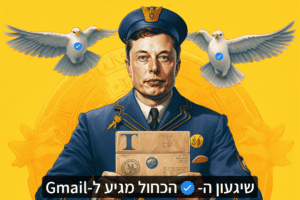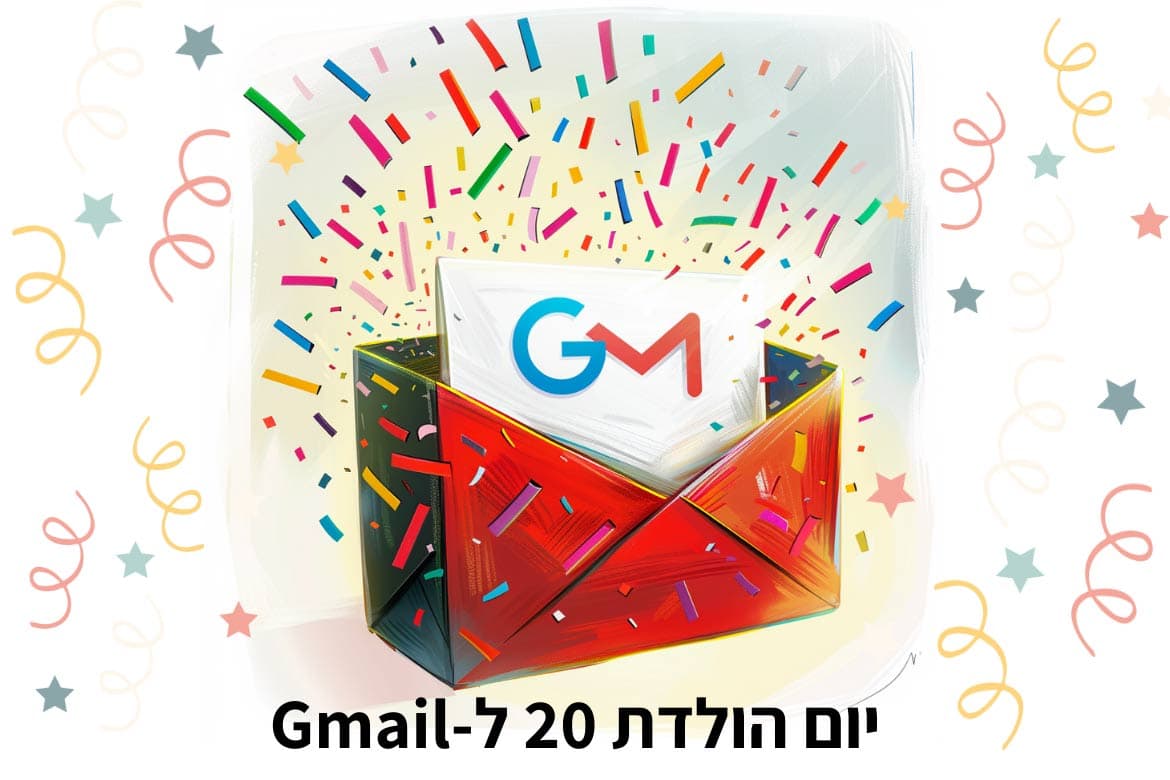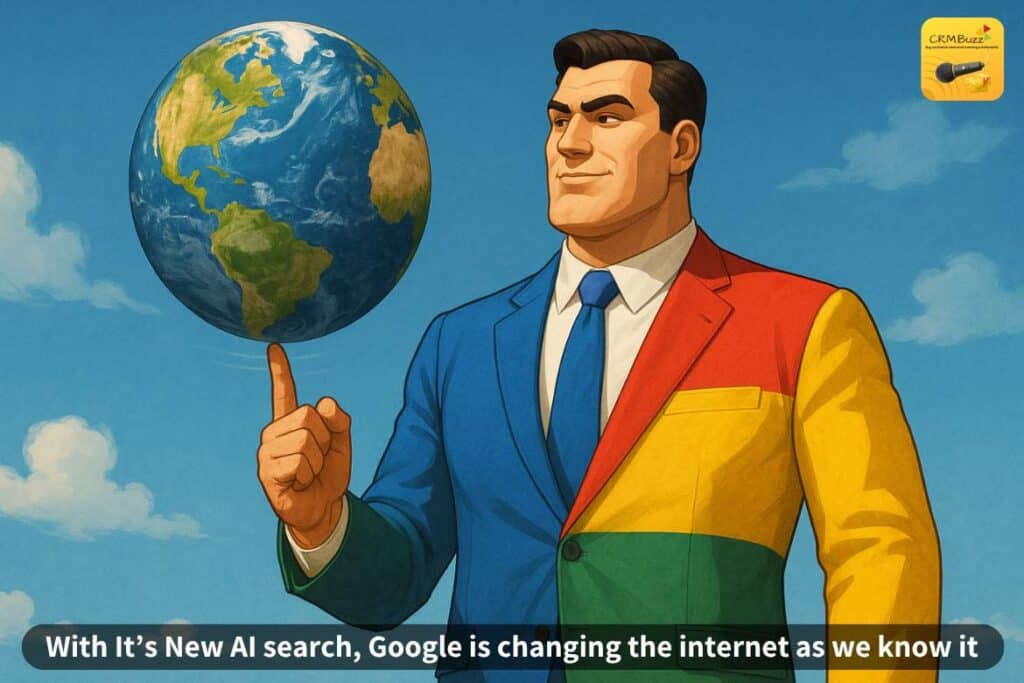Gmail is celebrating its 20th anniversary. Congratulations to Gmail. The mailbox provider that has become loved by it's users and challenges marketeers.
תוכן עניינים
20th birthday to…. Gmail
Gmail is Google’s email service launched on April 1, 2004, which led people to think it was an April fool’s hoax. It was launched with a capacity of 1GB, which was considered particularly large at the time, and in the early years was distributed in limited distribution. The service was officially launched on 7/7/2009.
In Israel, as well as around the world, Gmail enjoys great popularity and in certain territories such as Israel, Brazil and India, Gmail is the leading email inbox in terms of market share.
In order to improve the user experience of Gmail users, over the years Gmail has made groundbreaking procedures that have been a challenge for marketeers.
In honor of Gmail’s 20th birthday, we will get to know him better and mark some important milestones in our journey as users and of Gmail, which has become the leading email inbox in many territories, including Israel.
listen to the podcast

A podcast featuring the leading email marketing and email deliverability experts and email geeks.
I am Sella Yoffe, an email deliverability consultant from Israel. I work with global email senders, startups, and email service providers to improve their email deliverability and strategy.
Join us in this podcast, where top email marketing and deliverability professionals share their tips and advice.
—
Opening music from #Uppbeat (free for Creators!): https://uppbeat.io/t/reakt-music/deep-stone. License code: TPPQ0BDS5ZP1NWZL
Chad S. White is the head of Research at Oracle Digital Experience Agency.
Author of the 4th edition of the best-selling book: “Email Marketing Rules.”
Chad S. White is the author of four editions of “Email Marketing Rules” and nearly 4,000 posts and articles about email and digital marketing. Over the past 17 years, he has served as the lead email marketing researcher at four of the world’s largest email service providers—Oracle, Salesforce, ExactTarget, and Responsys—as well as at Litmus and the Direct Marketing Association.
Chad is currently the Head of Research at Oracle Digital Experience Agency, a global full-service marketing and communications agency within Oracle.
A former journalist at Condé Nast and Dow Jones & Co., he has been featured in over 100 publications, including The New York Times, The Wall Street Journal, and Advertising Age. Recognized as the No. 1 email marketing expert on Twitter, Chad is the ANA’s 2018 Email Marketer Thought Leader of the Year.
Connect with Chad or follow his work via his blog emailmarketingruls.com

Promotions tab
On May 29, 2013, Google changed Gmail’s user interface and added a built-in email filtering option to seven categories, and five tabs. The change has resulted in Gmail users’ email being filtered by categories and automatically distributed to different tabs, depending on content types, reducing clutter in the Main Tab.
Before the change, all legitimate mail arrived in a single Inbox and the illegitimate mail was moved to the SPAM box. Since the tabs were introduced, legitimate mail is scattered between different INBOX tabs. Users Gmail can search for content by category, even if the category isn’t set to a tab (five of the seven categories are tabs).
The most significant change is that marketing emails and newsletters are usually routed to the Promotions tab. The email industry was concerned that Gmail users would ignore the extra tabs and focus only on the main tab, but as it seems, this is not the case, and Gmail has created unique options for a promotional tab with Google Annotations that allows you to display a large picture of a sale, time-limited coupons, and more.
Many mistakenly think that the promotional tab in Gmail is spam. In practice, all Gmail tabs are part of the main Inbox, they are only divided into different categories. Emails redirected to the promotional tab ended up in Inbox, not spam. Emails that reached the spam are located in a separate box where the spam is kept, for example, for 30 days. Gmail uses advanced technologies and AI filtering mechanisms to manage emails.
“I remember writing about the tabs in Gmail when it first came out,” he told me in an interview onthe Chad S. Whitepodcast, author of email marketing rules and head of research at Oracle Digital Experience Agency. “And my advice is the same as it was then. The sky is not falling. This gives consumers a way to manage their email inbox better. And I know there was a lot of talk and even today we hear people talking about, “How can I get into the main tab? I compared the main tab to knocking on someone’s front door, being a door-to-door salesperson versus the promo tab being like the mall.”
“I think most retailers, most e-commerce companies today would rather be in a mall than go door to door knocking on people’s doors, disturbing them. I think that analogy still holds water today. Will your emails always land in the main tab, will they get more attention? Absolutely yes, but the goal is to be welcome and engaged. marketeers can attract all kinds of negative attention if they knock on everyone’s doors in the neighborhood. This is usually not the way to succeed. You really want to be where people expect you to be. I think in general, marketers, maybe learned that from advertisers. They’re like they’re very obsessed with attracting attention. And I don’t think it has anything to do with attention because, in email marketing, people have already chosen to hear from you by signing up for your emails and from now on it’s a question of relevance and not tactics and stunts to attract attention. I tell people not to be worried about the tabs at all. I sometimes hear people say that well, promotions aren’t inboxes but spam.”
New requirements
Google’s innovation was also reflected in a different approach to email filtering and spam, which was based quite a bit on positive and negative signals from Gmail users.
Gmail blocks about 15 billion unwanted emails every day and detects and blocks 99.9% of phishing, spam, and malware that reaches Gmail subscribers.
20 years after Gmail was born
, Google is updating the requirements formarketeers
in a joint venture with email provider Yahoo, and both have launched a joint initiative and set strict requirements formarketeers.
These requirements went into effect on February 1, 2024 and will be further tightened on April 1, 2024.
The new requirements are not new at all – they have been considered best practice for many years. But for many marketeers this is bad news because the impact of the demands is evident in a significant decrease in theirdeliverability .
The new requirements in brief:
It is no longer possible to email from the private Gmail using the mailing system: Google will block this option. marketeers who until now have supposedly sent emails from private Gmail via the mailing system should switch to using their business domain.
Domain verification – required: The business domain must be verified using domain verification protocols called SPF and DKIM. The mailing system will give you records that need to be embedded in the domain’s DNS. Domain verification actually authorizes the email system to send emails from your domain.
Zero tolerance for spam:
From now on, the threshold requirement for spam reports is not to exceed 0.3% spam reports and aim for 0.1% spam reports (one report out of a thousand emails that reached their destination).
You can’t see reports of spam from Gmail in the email system, only in Postmaster Tools. . Google just a few days ago added a new interface in GPT that shows whether the requirements apply to you asmarketeers and if so, whether you meet the requirements.
Publish a DMARC record: This can be a policy record none (p=none). My recommendation is to invest in a DMARC monitoring tool that allows you to monitor all the sources ofmarketeers named domains, do the DMARC campaign and at the end of the journey (several months accompanied by someone who understands the subject) switch to enforcement mode and enjoy “points” that will lead to an improvement in the offense data. Without enforcement, there will be no improvement in offenses, and of course, publishing a record in enforcement mode without proper handling (the DMARC campaign) will lead to blocks in case of domain verification problems.
Add an easy unsubscribe link: This is a link that the mailing systems will have to make. Make sure that from your email address you add a header that displays an unsubscribe removal link that will appear next to the email address and name of the sender. In order to display the link, there are some technical requirements, but as mentioned, the mailing systems are the ones that will be required to do so, and they have an extension until June 1, 2024.
Watch a webinar on the new requirements in the webinar
(available for newsletter subscribers).
“If you look at the numbers, Gmail inbox location rates are a little bit higher than other email providers,”
Guy Hanson
, vice president of customer engagement at Validity, tells me in an interview on the podcast. “The percentage of Gmail inboxing is about %-87% % compared to 85% on other providers. And I think, one of the reasons for that is Gmail’s filtering, which has always been very effective. They were one of the first businesses to adopt the use of artificial intelligence as part of their email filtering processes. In fact, there’s a story often told about how their Postmaster showed up at an email industry conference and was asked: What’s the secret to filtering your spam? What marketeers need to know to make sure they don’t end up in spam. And his response was almost amusing: because AI is now such an important part of our screening that even if I wanted to answer the question, I can’t, because AI is constantly learning and developing its rules (without human intervention).
Gmail has also put a lot of thought into its subscriber experience. They were the first to suggest to you whether you want to opt out of receiving emails from one mailer or another because we didn’t see that you had been involved with emails from that sender for some time. At the time, I think it caused a lot of marketeers to worry that it would cause people to remove themselves more than usual. But the opposite happens. This makes it easier for people to cancel their subscription. It made it easier to cancel your subscription, but by doing so, it lowered spam reporting rates, because that’s the alternative to canceling when you can’t find the unsubscribe link, instead, you just click Report Spam.”.
What else is new in Gmail?
Revolutionary topical filtering:
Gmail recently added a RetVec advanced text filtering mechanismthat significantly improves text email filtering.The RETVec module improves spam detection by 38% and, just as importantly, improves false detection accuracy (19.4% false positive detection improvement and 17.71% false negative detection).
Closing inactive accounts: Google announced that starting in December 2023, it will now begin a policy ofclosing email accountsthat have been inactive for two years. In doing so, it joins other email providers such as Yahoo, which has a similar and even tougher policy of removing accounts that have been inactive for 12 months (except for paid Yahoo Mail Plus accounts).
In practice, Google will start deleting private Gmail accounts (not Workspace accounts) and says that before deleting the accounts, it will send messages to both account holders and those linked accounts (such as accounts configured as backup password recovery). It will do so, as it puts it, “very carefully and slowly.”
The deletion will be not only of the Gmail account but of all products associated with the account, such as Google Drive, Docs documents, Sheets, etc. To keep an account active, the user must do one or more of the following simple actions under the specific user: read or send an email through Gmail, use Google Drive, watch a video on YouTube, download an app from the Play Store, perform a Google search, sign up or sign in with Google to a third-party account.
So much for a nutshell the story of Gmail celebrating its 20th anniversary.
Want to learn more about Gmail? Here are 3 more articles:

What do you need to know about the Gmail blue verification checkmark?
The blue checkmark on Twitter (now Twitter is called “X”) has become a status symbol and an important official stamp confirming the authenticity of the account. In a reality where distinguishing truth from falsehood becomes ever more challenging, social networks and other apps offer a verification seal, usually for a
Podcast interviews with international email marketing experts
האזנה לפודקאסט

A podcast featuring the leading email marketing and email deliverability experts and email geeks.
I am Sella Yoffe, an email deliverability consultant from Israel. I work with global email senders, startups, and email service providers to improve their email deliverability and strategy.
Join us in this podcast, where top email marketing and deliverability professionals share their tips and advice.
—
Opening music from #Uppbeat (free for Creators!): https://uppbeat.io/t/reakt-music/deep-stone. License code: TPPQ0BDS5ZP1NWZL
Welcome to episode 12 of emailgeeks.show, the podcast where email enthusiasts from around the world share insights on email marketing, deliverability, and strategies. Hosted by Sella Yoffe, an email deliverability consultant, this episode features Jakub Oleksa, founder and CEO of MailKit and Omnivery. Together, they delve into the fascinating world of non-human interactions (NHI) in email marketing, a phenomenon reshaping how marketers understand opens and clicks.
Key Discussion Points:
Introduction to Non-Human Interactions (NHI) [00:02:30]
- Explanation of NHI and its impact on email marketing.
- Differentiating between bot interactions and NHI.
The Role of Apple Mail Privacy Protection (MPP) [00:10:45]
- How Apple MPP affects open rates.
- Discussion on the rise of non-humans opens due to Apple MPP.
Impact of NHI on Email Marketing Metrics [00:25:00]
- Challenges in accurately measuring open and click rates.
- The effect of NHI on conversion rates and list hygiene.
Strategies for Dealing with NHI [00:40:15]
- Importance of understanding and suppressing NHI.
- How marketers can adjust strategies to account for non-human interactions.
The Future of Email Engagement Metrics [00:55:30]
- Potential industry standards for engagement metrics.
- The role of mailbox providers in providing reliable engagement data.
Advanced Solutions for Detecting NHI [01:10:00]
- Introduction to Omivery’s API for detecting non-human interactions.
- How ESPs and large senders can use advanced tools for better metrics.
Quotes:
– “Non-human interactions are those interactions that appear to come from the recipient but are actually performed by automated systems.” [00:05:15]
– “Apple MPP is definitely a non-human interaction… it loads emails in the background, making everyone seem active.” [00:12:30]
– “You cannot do list hygiene based on fake opens and fake clicks. You need to focus on real human interactions.” [00:50:45]
– “The biggest value of open rates is when you’re looking at open rates over time per destination.” [00:46:30]
Stay tuned for more episodes of emailgeeks.show, where we continue to explore the latest trends and insights in the world of email marketing. Don’t forget to subscribe and leave a review if you enjoyed this episode!
subscribe to our mailing list to get updates
EmailGeeks.Show Season. 1 Episode: 12
Copywrite: DATAMEDIA | Sella Yoffe
Podcast Page: Email Geeks Show website
Episode Page: https://emailgeeks.show/jakub-olexa-nhi-non-human-interactions/
———————
opening music: https://uppbeat.io/t/reakt-music/deep-stone
License code: TPPQ0BDS5ZP1NWZL

אני סלע יפה, מומחה אימייל מרקטינג ועבירוּת אימיילים. אני מזמין אותך לפגישת יעוץ ראשונית של 1/2 שעה ללא עלות בנושא עבירוּת אימיילים ואסטרטגיית אימייל מרקטינג. book an email deliverability discovery call.
Further reading

Sella Yoffe
Email Deliverability & Email Marketing Expert
Helping global email senders, startups, digital agencies, and ESPs with email deliverability, email authentication (SPF, DKIM, DMARC, BIMI), and email & content strategy
Podcast creator & Blogger @ CRM.BUZZ & EmailGeeks.Show





